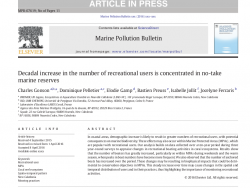
Decadal increase in the number of recreational users is concentrated in no-take marine reserves. Charles Gonson, Dominique Pelletier, Elodie Gamp, Bastien Preuss, Isabelle Jollit, Jocelyne Ferraris. Marine Pollution Bulletin
a b s t r a c t
In coastal areas, demographic increase is likely to result in greater numbers of recreational users, with potential consequences on marine biodiversity. These effects may also occur within Marine Protected Areas (MPAs), which are popular with recreational users. Our analysis builds on data collected over a ten-year period during three year-round surveys to appraise changes in recreational boating activities in coral ecosystems. Results show that the number of boaters has greatly increased, particularly so within MPAs during weekends and the warm season, when peaks in boat numbers have become more frequent. We also observed that the number of anchored boats has increased over the period. These changes may be resulting in biophysical impacts that could be detrimental to conservation objectives in MPAs. This steady increase over time may cause changes in the spatial and temporal distribution of users and in their practices, thus highlighting the importance of monitoring recreational activities.